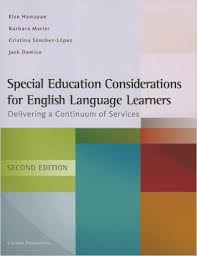Several myths prevail in the area of special education for ELLs. These myths guide us in the way we approach education in general, in the way we interpret students' behaviors, and in how we teach and assess students. The following are commonly held misconceptions regarding ELLs and special education.
Response
A special education placement when none is warranted does not serve the student well. First, we are bestowing on the student a stigmatizing label that the student does not need. Second, interventions that are specifically geared to help processing, linguistic, or cognitive disabilities often do not help children acquire second language proficiency. In fact, special education services can limit the kind of learning that ELLs need (Gersten & Woodward, 1994). Special education interventions tend to target a narrow selection of skills to enable mastery, and discrete skills are often practiced out of context (Damico & Damico, 1993a; Westby & Vining, 2002). This complicates the learning process for ELLs, since they need a meaningful context in order to comprehend the language that surrounds them (Genesee, 2006).
In addition, special education interventions often use reading materials with controlled phonics and vocabulary, which reduces the meaningfulness of the text. Intervention tasks often revolve around surface structures of language, targeting grammar, syntax, and spelling. This constricts language usage and makes it more difficult for ELLs to understand and retain information (Gersten & Woodward, 1994).
Response
Although it is true that ELLs may take five to seven years to develop proficiency in academic language (Cummins, 2006), there is no need to withhold any kind of support services that an ELL might need in the meantime. The timeline suggested by Cummins was meant to give teachers a sense of how much to expect students to learn through a language that was not yet fully developed, especially in abstract academic concepts. Besides, if a student truly has an intrinsic difficulty, then it exists in all the student's languages and in most use contexts.
The sooner these exceptionalities are identified and supported, the better opportunity the student has to be successful in school.
Response
Children with speech, language, or learning impairment can become fully bilingual (Genesee, Paradis, & Crago, 2004; Perozzi, 1985; Perozzi & Sanchez, 1992). There is even emerging evidence that children with Down syndrome can be successfully bilingual and that bilingualism does not disadvantage their language development (Kay-Raining Bird, Cleave, Trudeau, et al., submitted). The majority of people in the world are bilingual, and some of them have disabilities. Disabilities certainly do not arise from being bilingual. They manifest in all or most contexts. The decision to shift to instruction in English exclusively is usually based on lack of knowledge of the research, ignorance of the students' native language, or convenience. Developing the native language can help students with a specific language impairment (SLI) make better progress in the second language.
In addition, for ELLs with severe disabilities, it is especially important to maintain the home language, since the students' main caregivers will be their parents well after they have left the school system and have entered adult life. It is important that parents and family be able to communicate with and have close ties to their children.

 This article is an excerpt reprinted with permission from
This article is an excerpt reprinted with permission from 





Comments
Karen Andreasen replied on Permalink
Teachers and administrators should give ELLs time to adjust before evaluating a child. In order to evaluate a child fairly, we must find out if the perceived deficits exist in L1. ie. does the child have memory problems, word retrieval difficulty in L1,or delayed expressive language? If so, the child's difficulty may be neurological and may require special services, but they should also receive ESL support.
Lora Abbott Dietrich replied on Permalink
It is exciting to see this challenge finally being addressed across the board. As an ESL teacher with Special Ed and Reading Specialist certificatons, I've discovered there are many misconceptions. Thank You!
Bill Barchers replied on Permalink
I was completely suprised by Myth #3. The fact that Downs learners can become bilinqual is one of the most encouraging things I have read in a long time.
DL replied on Permalink
should intermediate ELEM ELLs be placed in SPED reading groups because they are reading on the SPED reading levels only because they have not required English yet? Many schools say they have to be in a reading group and that is where they "fit" until they can read with their non SPED peers.
Gail replied on Permalink
Been an educator for 38 years. An ESOL student needs someone special to evaluate them...someone who speaks their language. That is the only way to determine if they are special needs. If someone not qualified tests, the test is invalid. Hard to find these testers...I know. So...educators...be very careful when putting a disability on students that are ESOL. Make VERY sure they have needs and it's just not a language barrier.
Mary Ann replied on Permalink
What about children that are ELL and are dyslexic. As an LBS, methods utilized in the public schools (direct intense reading instruction) are not available in native languages. I have found these methods helpful in teaching the ELL to read in English. Is it still recommended to keep the native language instruction going when data indicates there has been no growth at a Tier 2 native language instruction.
Add new comment